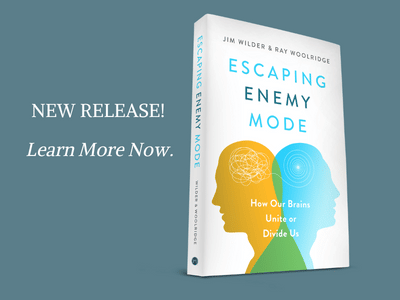By Ray and Deborah Woolridge
When have you had an enemy mode conversation with someone you love? How does it feel to you? How does it make them feel? As a couple married 36+ years, enemy mode feels like falling down a cliff. Falling into enemy mode is much easier than climbing out of it.
We think escaping enemy mode requires a team, like rock climbing. To safely descend a cliff, the climber needs both rope and harness, and the physical and mental ability to descend safely. But a second ingredient is someone to help you when you are losing it. In climbing, this is the person on belay.
The belay person is securely anchored below on the cliff, ready to rapidly pull the rope if the climber is descending too fast. Two belay men saved Ray’s life in Army Ranger school when he lost proper body position.
Escaping enemy mode requires the same two ingredients as climbing: the physical/mental and the belay person. As a couple, we have been working on this and will be, for the rest of our lives. Step by step, we are getting better at recognizing enemy mode, admitting it, and helping each other escape it, together.
I (RAY) can get stuck in simple enemy mode and miss a relational connection. Sometimes, I can fall into stupid enemy mode, erupting angrily and hurting someone I love. Occasionally, I resort to intelligent enemy mode by maneuvering the interaction and manipulating the person for a win in my favor!
What is helping?
Do you know what enemy mode feels like in your body? Like knowing how to descend a cliff with rope and harness, recognizing what your body is telling you is a physical activity which improves with practice. Your right hemisphere is communicating to your left hemisphere. For Ray, enemy mode feels like this: heart racing, vision narrowing, a sense of “I am all alone to fix this problem.” Over time, when that “feeling in my body” comes back, we can train our brain to recognize our own enemy mode physical symptoms and self-arrest. What happens when we miss our body’s signals and we are rapidly falling down the cliff into enemy mode?
That’s where our belay person comes in. Like a belay person tightening the rope to prevent a fall, what happens when Deborah notices Ray falling into enemy mode again? She does what Ray has asked her to do: tell him. She is Ray’s “rescue attachment” who can say to him “you are in enemy mode” and expect to work it out relationally.
The main way enemy mode has impacted our marriage stems from Ray’s dismissive attachment style. Our journey into living the Life Model has taken us into three years of Thrive Training. Ray’s working with Jim Wilder to write Escaping Enemy Mode: how our brains unite or divide us? has given us many opportunities to practice what we have been learning.
I (Ray) eventually realized that my “go-to” tool for success was enemy mode, whether simple (just being non-relational), stupid (losing it) or intelligent (manipulating the situation for a win for me). I have been shocked to notice how well-worn the path to enemy mode is for me. I still can fall into enemy mode all too often.
I (Deborah) bear the emotional scars of Ray’s enemy mode. I have hope that we are escaping enemy mode in our marriage, but this is a daily journey of surrender and submission to the Lord and to one another.
A year ago, I (Ray) got fired up about something and was falling into enemy mode. I had asked Deborah to help me notice enemy mode. When she bravely pointed it out, I was not happy. To her statement, “You are going into enemy mode!” I immediately rebutted, “no, I am not!” She firmly insisted “yes, you are.” She bears the scars of my enemy mode. I didn’t get it. I was stuck on winning the argument and proving that I was not in enemy mode. But I was, and we both knew it.
I (RAY) am changing in this season, but re-training the well-worn neural pathways of the brain takes time. I am seeing change, gradually, after years of relational brain training. With the help of a good therapist, I am becoming a more relational man. I am discovering Jesus in the wounds of my past, and he is healing them. This journey has been painful but necessary to become the man I was created to be. My part is to work on addressing my maturity gaps and focus on growing into a man who treats others like Jesus does.
Recently Deborah noticed me falling into enemy mode before a conversation with a sales manager. My “enemy mode” signs are clear to her: a stiff jaw, fixed gaze, crossed arms. She pointed “enemy mode” out to me. I am beginning to recognize the signs more often also: elevated heart rate, my head feeling hot, my voice raised. As soon as she pointed it out, I noticed what my body was telling me.
I looked her in the eyes and said, “you’re right, I am.” I took some deep belly breaths. I remembered who I wanted to be and how I wanted to have a good day with my wife. I silently asked Jesus to help me.
What is helping me is a rescue attachment: a lifeline when I am in distress. Deborah is my lifeline. She models relational attachment to Jesus and to people. She helps me notice when I miss signs of my enemy mode. She reminds me who I am. She encourages me to surrender and submit to God, remember my identity, and to ask “where is Jesus right now? What is He saying to you?”









